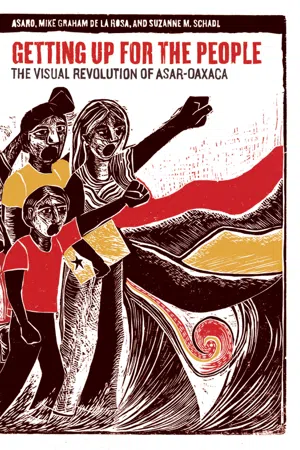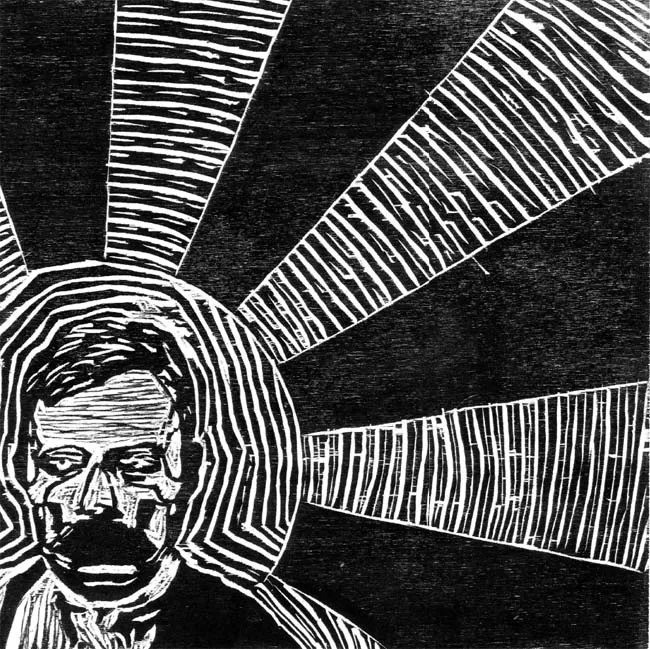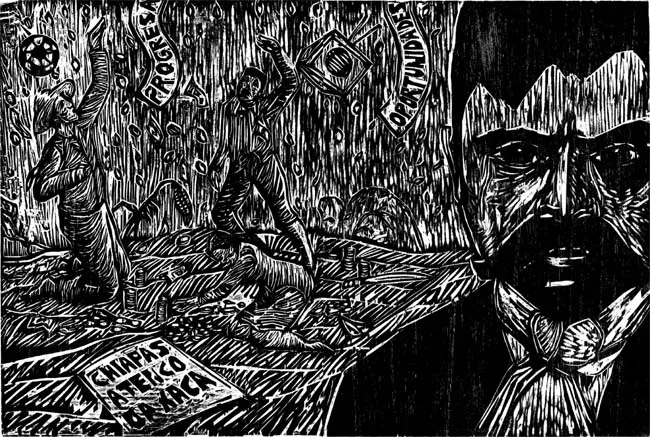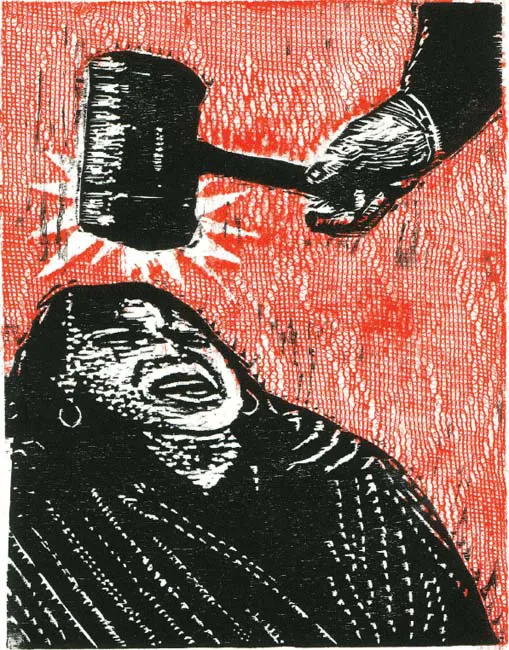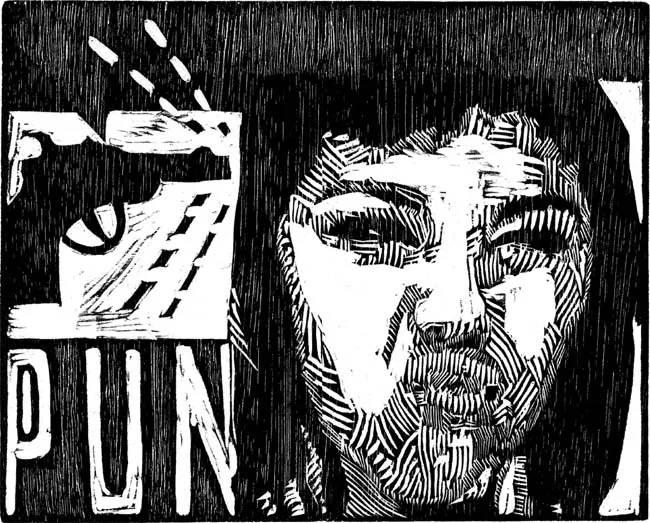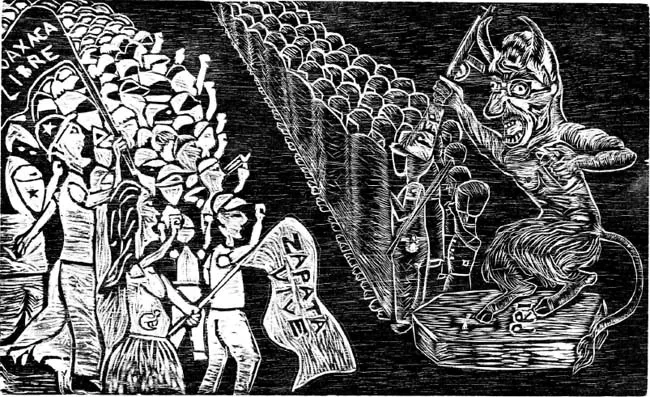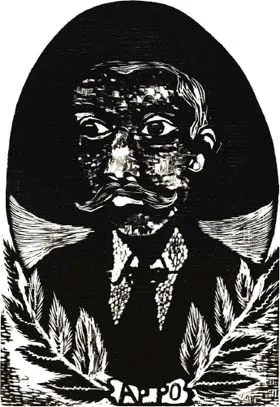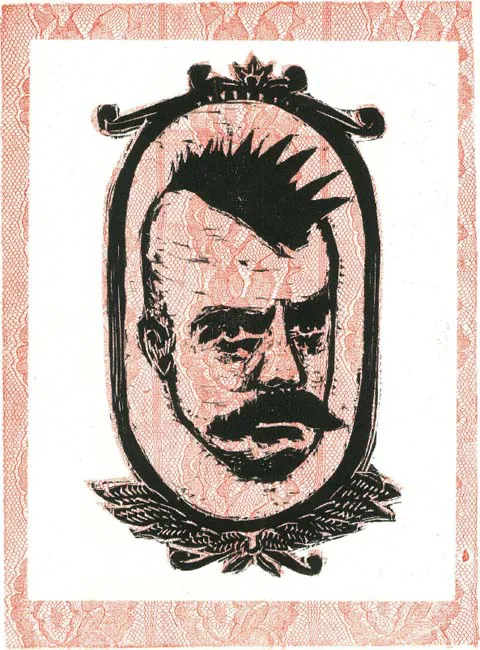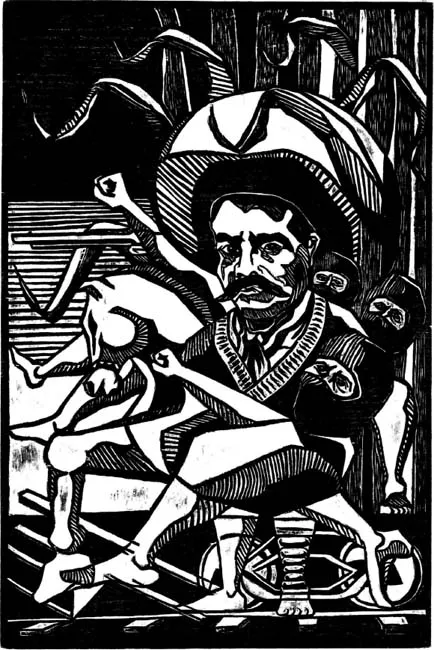![]()
PA’L PUEBLO/FOR THE PEOPLE
“We propose to start an art movement in order to be in direct contact with people in the streets and public spaces.” —ASARO Manifesto
“We believe that artistic expression needs to be a form of communication that allows dialogue with all sectors of society and enables the display of real existing conditions, rules, and contradictions of the society we inhabit.” —ASARO Manifesto
“Represent” is a loaded term and the act of representing is equally charged. On the one hand, the verb means to speak for or, alternatively, to stand on behalf of another. On the other hand, it signifies presenting something anew. Art for the people necessitates both of these practices acting together as reflected in the sixth and seventh statements of ASARO’s manifesto. Public art also embodies another relevant definition of this verb: to portray or set forth in words or symbols. The Spanish language extends this last notion into the dramatic arts where a performance is “represented” rather than acted.
ASARO employs performance in planning and implementing their interventions, thus depending upon audience response. Their street projects are comprised of multiple connecting pieces drawn from complimentary fragments, each with their own signification. Spectators who see the resulting work as a big picture read it differently from those who see the details within it as separate, isolated statements. This process modifies the originally intended message while at the same time revealing the problem inherent in speaking on behalf of others. The audience has a voice, too, and more often than not their participation adds to or subtracts from the representation, creating something new. While some audience members may represent the work as important cultural patrimony, others might portray it as unnecessary vandalism. In either case, they assign the performance a value that is intrinsically social.
Zapata in Sunlight, 2010, block print, 14 ¼” x 13 ½”.
As an urban countercultural youth movement in a peripheralized state, ASARO creates pieces that blend urban hip hop ideas with the indigenous concepts of communality. For this reason it is important to recognize that opposing hip hop definitions for the term “represent” fit well within a culture that embraces the hip hop notion of setting a good example while standing in as representative of a community, as well as its opposite meaning of annoying others with your presence. The ranks of the EZLN in their masks embody this notion of simultaneously standing for a community and serving as a taxing reminder of indigenous perseverance. By nature of its place among the people, street art also accomplishes both of these objectives; its ability to do so is likely why some ASARO artists see it as the preferable medium for representing the pueblo.
“The strongest and most important art is in the streets.” —Yescka, ASARO
Print work is also provocative of audience participation and transformation as well as communal persistence; consequently, it has occupied an important place in Mexican history and art. Prints are the result of putting an engraved block to ink and paper so their images can be repeated in different inks and papers. They are thus represented in wheat pastes glued to exterior walls, fliers, and pamphlets generated through street networks, electronic media, and collectable prints exhibited in either public or private galleries.
Chiapas, Atenco, Oaxaca, 2011, block print, 27 ½” x 19 ½”.
“Initially we sold our pieces to support infrastructure, to pay for a workshop space and supplies. Once we made a little more, we sought to create spaces for exhibiting and disseminating our works and those of other collectives. We want this material to reach more people.” —Mario, ASARO
The print extends ASARO’s audience beyond people physically present in the streets of Oaxaca, inviting a wider audience to value the images by interpreting and representing them.
Zapata
Speaking for and representing something significant enough to be meaningful for a community requires an engagement with deeply embedded symbols in that community as well as a dependency on already agreed-upon visual cues. Throughout Mexico and in much of the Mexican-American or Hispanic Southwestern United States, the image of Emiliano Zapata equals revolutionary. A smaller grouping within a disperse community sees him more familiarly as a man of the rural people, representing their rights to land. In this sense, Zapata’s image is the periphery fighting back for possession of their land. His representation is invoked for these purposes even outside of Mexico by those marginalized as a result of colonialist and imperialist land-grabbing. This sentiment is well reflected in the northern New Mexican slogan “Tierra o Muerte,” meaning Land or Death and used repeatedly with Zapata’s image in the late 1960s by La Alianza, led by Reies López Tijerina.
In Oaxaca the revolution that Zapata led lives on as its population fights to resist authoritarian political structures and capitalist economic priorities that persist today, more than a century after the beginning of the Mexican Revolution. Zapata may stand even stronger now as the iconic symbol of an unfinished movement.
“Today we have more access to images; and sometimes, while mixing what you learned in fine arts, you come across some other icon, a new visual space through graffiti. These icons and personages are mediums for young people to express power.” —César, ASARO
Woman Being Hammered, 2010, block print, 14” x 19 ½”.
Pun, 2010, block print, 13 ½” x 12 ½”.
Oaxaca Libre, Zapata Vive, 2006, block print, 27 ½” x 19 ¾”.
It is his heart that beats from the grave representing contemporary movements in Atenco, Chiapas, and Oaxaca. Despite the groundbreaking constitutional reforms of Mexico’s 1917 constitution which established provisions throughout Mexico for free, mandatory education, land reform, and workers’ rights, too many Mexicans suffer without access to education or property while a select few prosper beyond anyone’s wildest imagination. Even as more than half of Mexico’s population hovers near poverty, multi-billionaire Carlos Slim and drug lord Joaquín Guzmán are among the richest men in the world. Despite statistics suggesting middle-class growth in Mexico, most people struggle. Opening Mexican markets to international businesses has resulted, generally speaking, in crippling local entrepreneurs or abusing resources in short supply. Deals between top players and high-ranking government officials have effectively excluded the Mexican majority. Opportunities are slim (pun intended).
Zapata and APPO, 2010, block print, 19 ½” x 27 ½”.
To add to these grievances, state control also remains with the ruling Revolutionary Institutional Party (PRI). This clientelist political party has controlled political opposition in Mexico since the period following the Mexican Revolution. It has generally maintained power with the occasional exception of the conservative National Action Party’s (PAN) gain of the presidency under Vicente Fox (2000-2006) and Felipe Calderón (2006-2012). It recently lost the governorship in Oaxaca to a new, more liberal coalition comprised of Workers Party (PT) and Democratic Revolutionary Party (PRD) members who unseated Ruiz Ortiz in 2010. It is difficult to separate these anomalies from PRI ranks, however, because so many of the PRD candidates, including current Oaxacan governor Gabino Cué Monteagudo and some PAN membership, were once PRI functionaries. Since pragmatism rather than ideology generally underlay these changes of heart, it is difficult not to wonder when they might revert back. Regardless of party affiliations, the Mexican national government maintains the guise of stability through repression, caring little for the social cost of injustice.
XX-XXI Revolución, 2008, block print, 19 ½” x 27 ½”.
ASARO, Punk Zapata, 2010, screenprint, 13” x 18”.
Cubist Zapata, 2010, block print, 19 ½” x 27 ½”.
In this environment, Zapata represents social expectations for systematic change. ASARO reappropriates his iconic image to speak for other Oaxacans and Mexicans in a symbolic act of taking their country back from the PRI as in Oaxaca Libre, Zapata Vive (Free Oaxaca, Zapata Lives). In this print, a rat-like figure leads a military stand against people advancing Zapata’s revolutionary ideal of communal ownership and workers’ solidarity. The crowd carries his banner and embodies his perseverance with flags stating: “Zapata Lives” and “Oaxaca is free.” In other words, the print says “Oaxaca is getting back up and it understands Mexico’s revolutionary struggles and losses as part of its own history.” They are readied to take it back from the repressive ranks and the monstrosity that the P...
